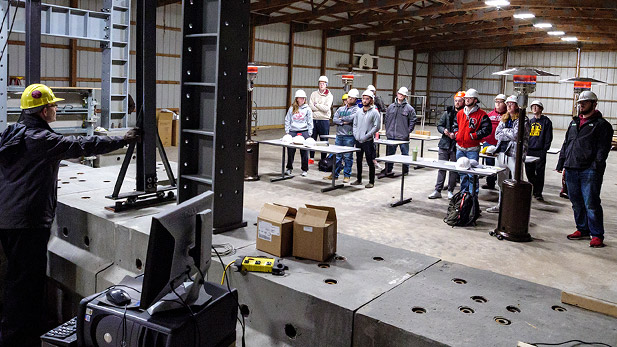New Modular Learning Lab Providing Realistic Civil Engineering Experiences

The Department of Civil and Environmental Engineering’s new modular strong-wall structural testing lab is used to demonstrate the behavior of structural steel frames when subjected to lateral loading.
A new structural testing laboratory is engaging Rose-Hulman civil engineering students in high-impact experiential learning exercises where they can gain valuable insight into the behavior of large-scale structures and building foundations, and then utilize that knowledge to become better design engineers.
The modular learning facility was provided through the National Science Foundation’s Improving Undergraduate STEM Education program. Rose-Hulman shared in a $599,821 grant with professors from Saint Louis University. The lab is located inside a building on former Hulman family property adjacent to the main campus. The land was acquired by the institute in 2017.
The laboratory gives the Department of Civil and Environmental Engineering testing capabilities typically only available at larger research universities, according to professors Matt Lovell and Kyle Kershaw, who organized the lab.
The facility’s equipment is primarily being used in courses examining the structural design of concrete and steel, geotechnical engineering, construction and foundation engineering, and structural design in prestressed concrete. The lab also will allow students to work on undergraduate- and graduate-level research projects that were previously not available on campus.
For instance, the lab’s soil test box used in soil mechanics and foundation engineering courses this fall allowed students to use theoretical methods to predict the behavior of building foundations. Then, they could test the foundations to assess the applicability of their predictions.
Course instructor Kershaw says, “Being able to observe and measure behavior is particularly exciting for me as a geotechnical engineering faculty member, because most of our work is built below ground where it is difficult to observe behavior, especially in a classroom setting.”
The lab has a modular strong-wall testing system, with 12-cubic-yard concrete blocks, to which projects can be attached and tested. The system, which is strong enough to support simulated earthquake-strength level loads, was put to the test this fall for students in structural mechanics courses taught by professor Jim Hanson. The new equipment was used to demonstrate the impact of structural frames, floor systems, and connections when subjected to lateral loads. Previously, professors used videos and computer models to show how these structural elements react to different applied stresses.
“These classroom lab testing procedures reveal the behavior of structures in a scale that’s much more realistic, allowing students to really examine and appreciate what’s happening in a real-world environment. Then, students can compare what they have observed with their original hand calculations. It provides experiential learning opportunities that help students understand the mechanics much more effectively,” Hanson says.
Students will build multiple full-scale concrete beams during the winter academic quarter to examine what happens in real-world situations.
“The new lab gives the Department of Civil and Environmental Engineering testing capabilities that are typically only available at larger research universities,” Lovell says.
He points out that professors will also use the lab to examine how students learn civil engineering concepts through experiential learning. That’s another key element of the NSF grant awarded to Rose-Hulman.